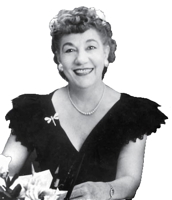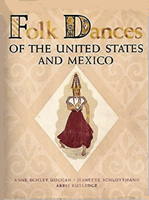
|
The Society of Folk Dance Historians (SFDH)
The Folk Dance Library
Home |
About |
Encyclopedia | CLICK AN IMAGE TO ENLARGE |

|
Information: A series of books.
Volumes 1-5. Anne Schley Duggan (see photo above), Jeanette Schlottman, and Abbie Rutledge. New York: Barnes, 1948; reprinted New York: Arno, 1980. Directions and music for 83 dances from 7 geographic regions. Illustrated.
REVIEW
Review by Vyts Beliajus in Viltis.
"Ann Schley Duggan, Professor of the Texas State College for Women, with the collaboration of Jeanette Schlottmann and Abbie Rutledge, have put out a very ambitious collection of five volumes of folk dances. One volume deals with suggestions of how to teach folk dancing, the other four are folk dance descriptions. All sections are preceded with geographic and historic information concerning the dances described. The volumes are cloth bound, the jackets on each being most attractive, and each section has a plate in color showing costume designs. The information, not withstanding the fact that Dr. Duggan warns against misinformation, must be carefully sifted. One can see that many of her facts were obtained from what "others done tole her" and read in other books. In one place she has the White Russians (Byelorussians) and the Little Russians (Ukrainians) lumped together as "Centering about Kiev" which is incorrect. The Byelorussians center about Minsk, wedged between Poland, Lithuania, and Muscovy Russia. There are over five pages of printed matter about Russia but only two dances, both, Eastern versions, and the "In The Garden" (Vo Sadu) of "questionable origin."
It is a pity to see so beautifully put out a collection containing so many old, tried, printed, and reprinted material taken from other collections, the sweat of others. The dances, for the most part, are simple, except for a few Mexican and Tyrolean numbers. And in the English dances, she certainly didn't improve much on Cecil Sharp's descriptions. For some dances the names are misspelled. For the "New Bavarian" (See Dance and Be Merry, Vol. 2) she gives the German name as Neubavarische." First of all, no German would say "Bavarians" in English, but call them "Bayern – Bayerische." All nouns in German are capitalized, even a "table," and most certainly the name of a people or a country. The Weggis Dance, ascribed to Switzerland, saw its first daylight (or, nightlight) in New York, and is still unknown to the country to which it is attributed. She speaks of the "Kolo" as if it were one dance with different versions; while in truth, there are kolos by the hundreds. Her French dances are probably new to most people, but the selection is poor, and none will be too thrilled with them (perhaps with the exception of the Gavotte Guemene and the Jabadao). They'll find Hora simpler and more interesting. The dances, though, are all of old origin. The Stoupic, as she describes it, has some faults: 1) The language of the one verse she gives in her collection is "modern," and not the original vernacular in which it is sung; 2) the name of the location is "Och'mine" and when speaking of the town "De l'Och'mine" would be grammatically correct. Dr. Duggan has it "D'Locmine" which is wrong even when spoken in "patois" (dialect); Part B of the dance is a tapping of feet (about 32 times) which is most un-interesting and tiresome.
The Mexican section in the volume "Folk Dances of the United States and Mexico" is worthwhile. It contains La Virgencita (which is another version of La Raspa), Los Matlanchines (as Lloyd Shaw dances it), La Cucaracha, Las Iguiris (a dance for women), Los Viejitos, and the Jarabe Tapatío. (All of these dances appeared in other collections). Regarding the China Poblana dress, according to the information I received from the Mexicans, is, that the China Poblana dress was "Made in Mexico" by a captive Chinese princess, but that it was NOT brought from China.
For the most part, this work is rehashed material and much of it is very elementary. But it is beautifully assembled and a great deal of work was put into it. The list of dances follows and they might be new to many of you who have no other collections. A. S. Barnes and Co., New York, are the publishers."
CONTENTS
- The Teaching of Folk Dance. Directions for teaching dances and producing festivals; nothing about the dances.
- The Folk Dances of Scandinavia. 23 dances from Denmark, Finland, Norway, and Sweden.
Denmark: Danisch Schottische, Crested Hen, Danish Minuet, Little Man in a Fix, Danish Masquerade, Varsovienne
Finland: Schottische, Finnish Polka, Radiko (Raatiko), Kerenski, Kynkkaliepakko
Norway: Rugen, Tantoli, Ril, Feiar, Little Four Dance, Reinlander
Sweden: Gustaf's Skol, Varsouviene, Schottische, Ox Dansen, Hambo
